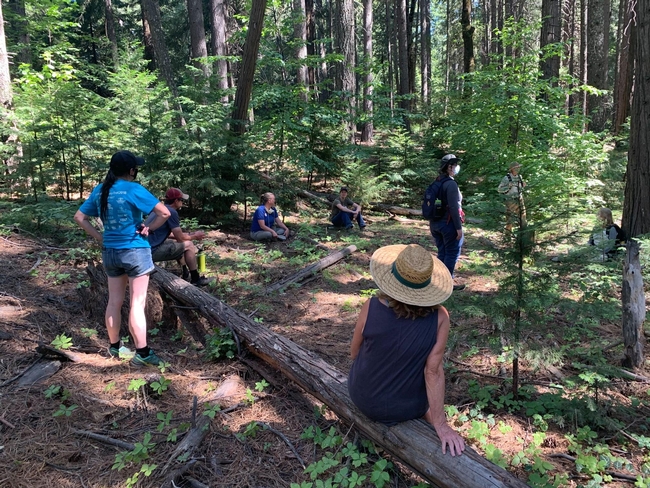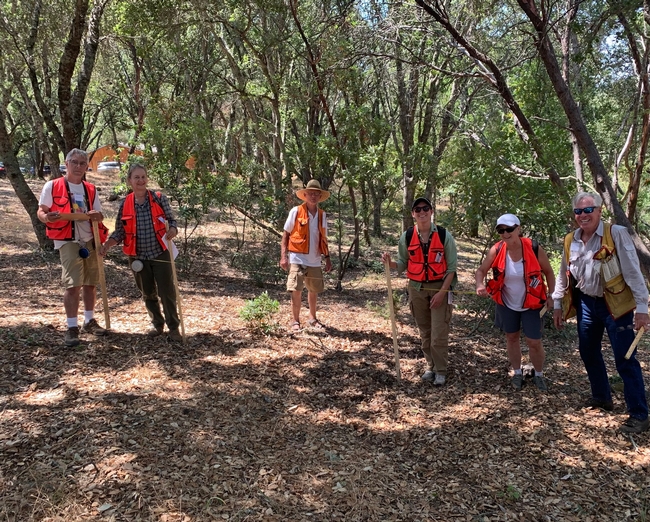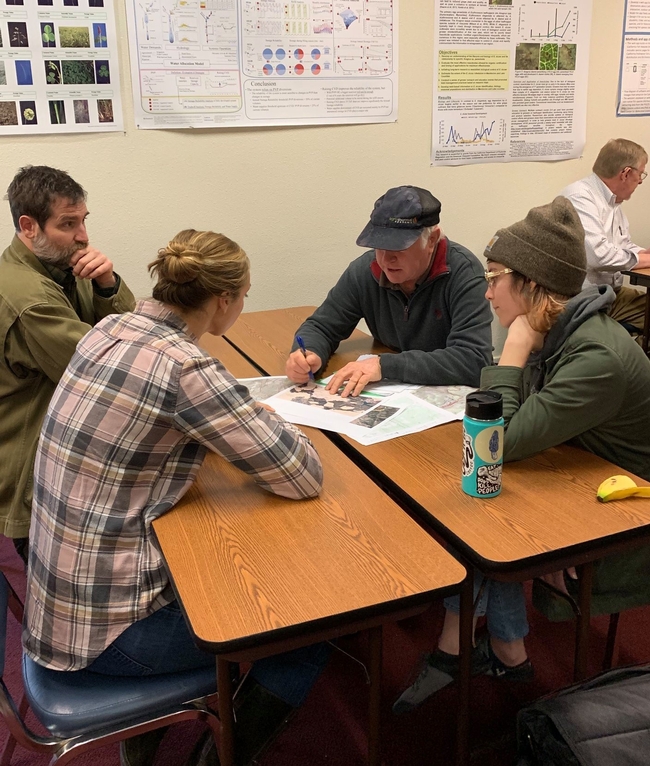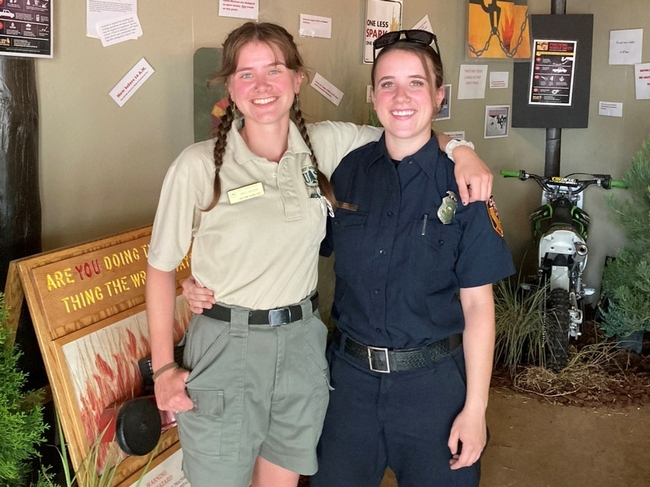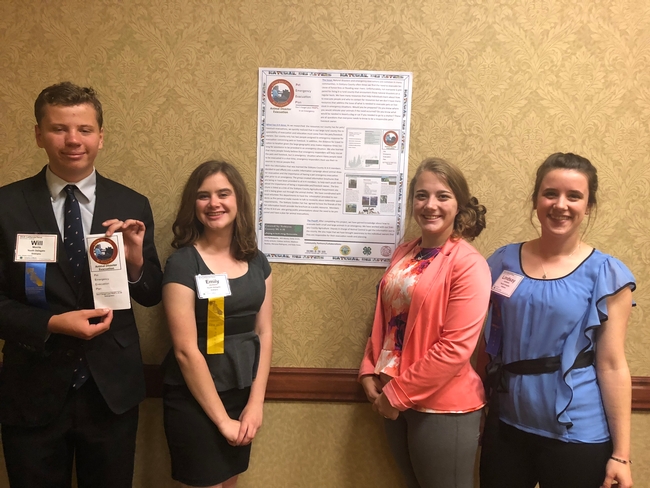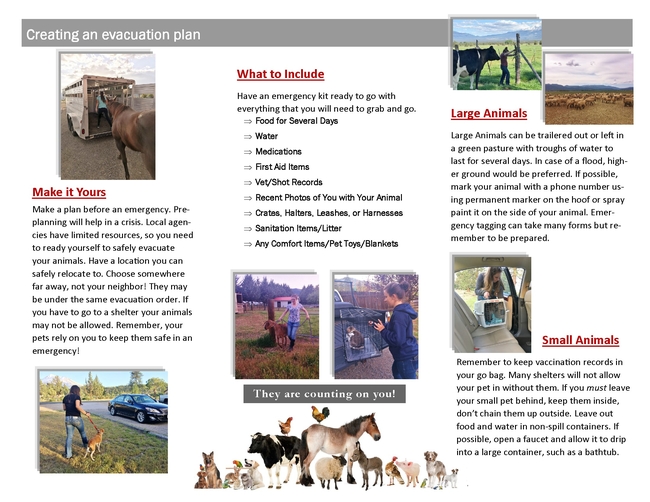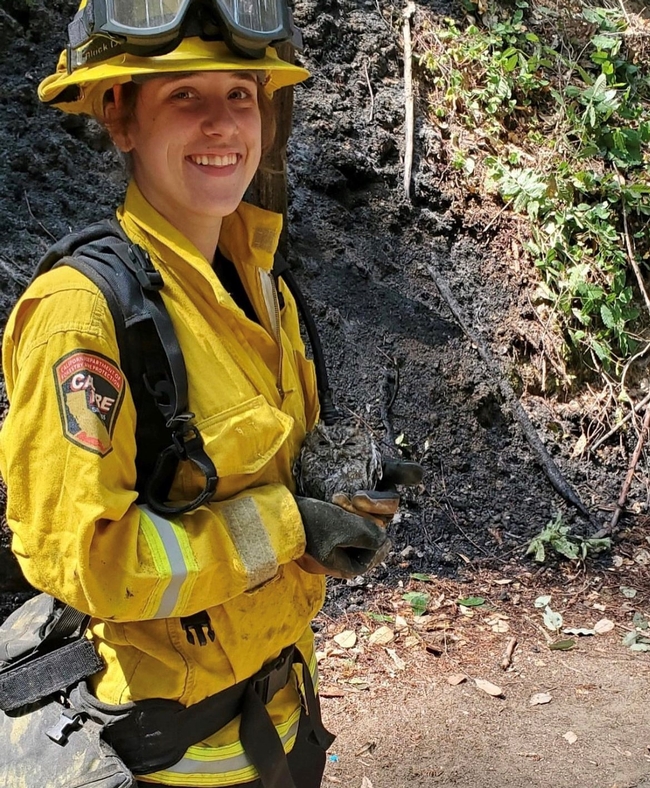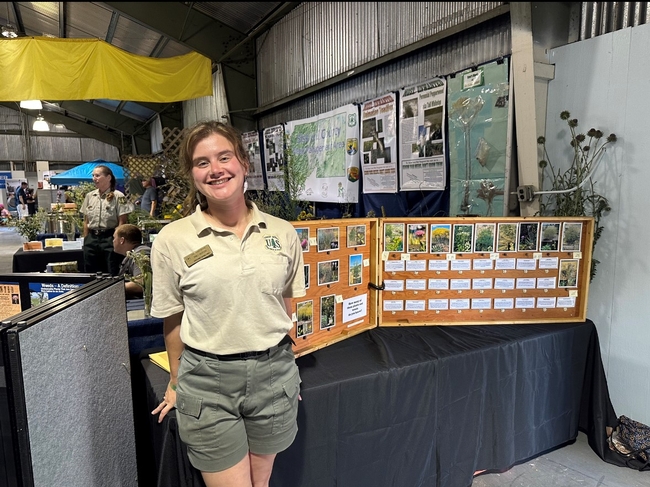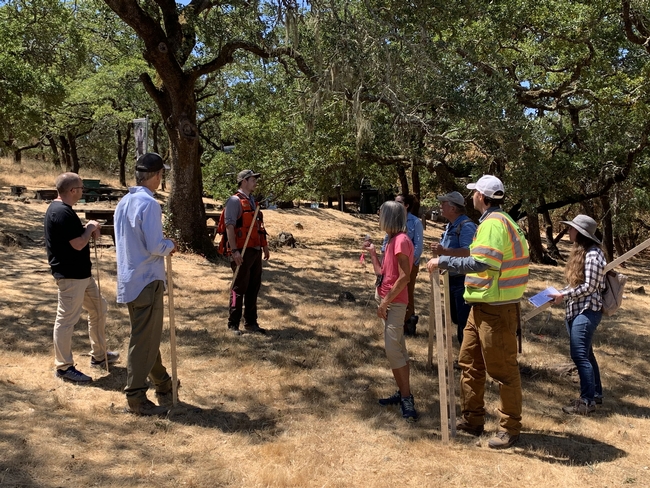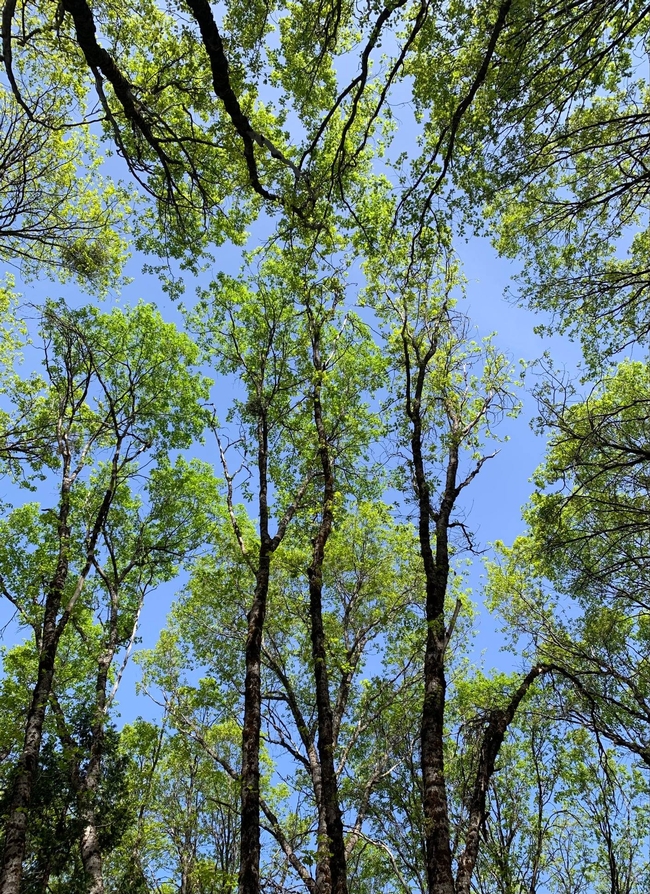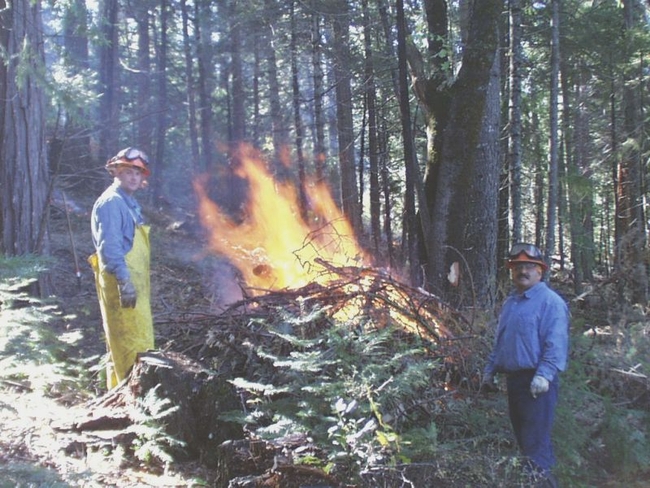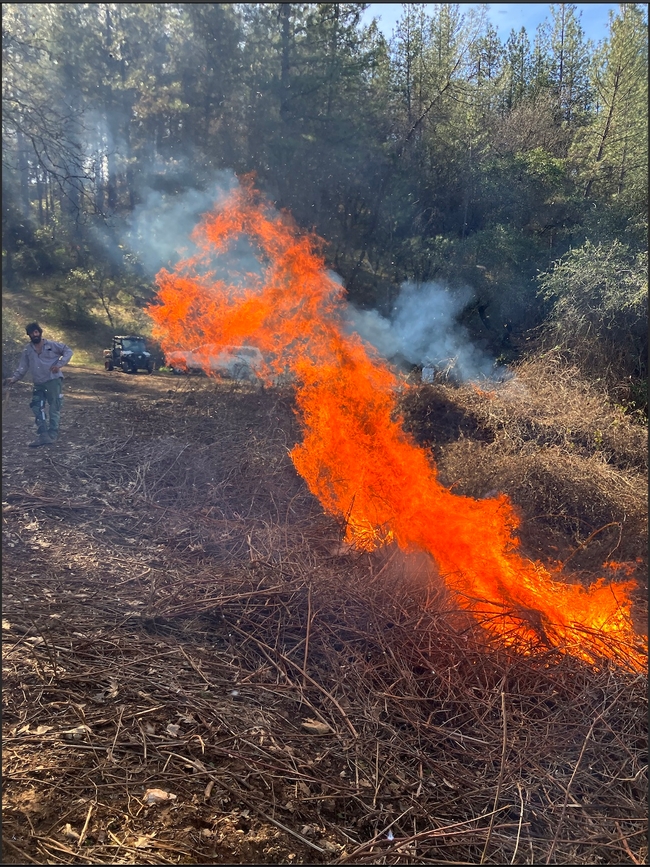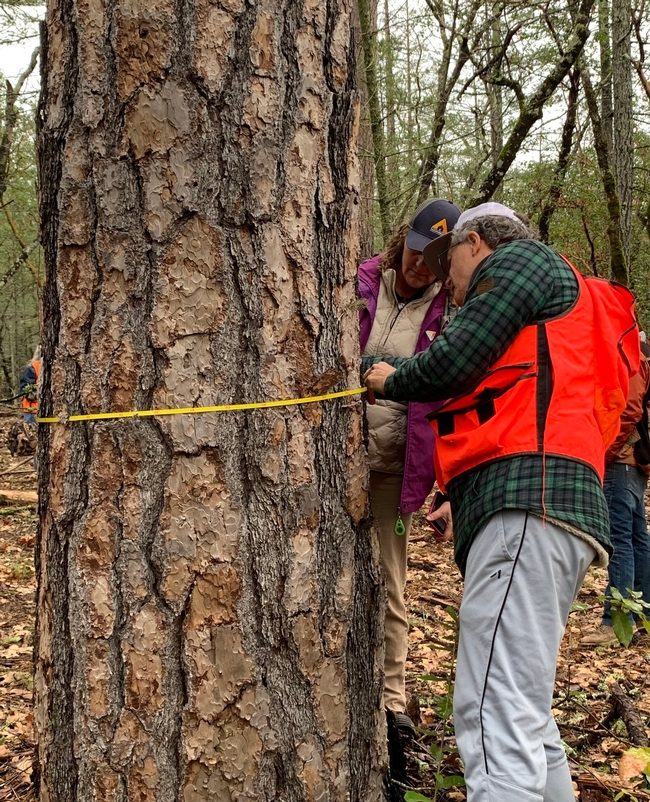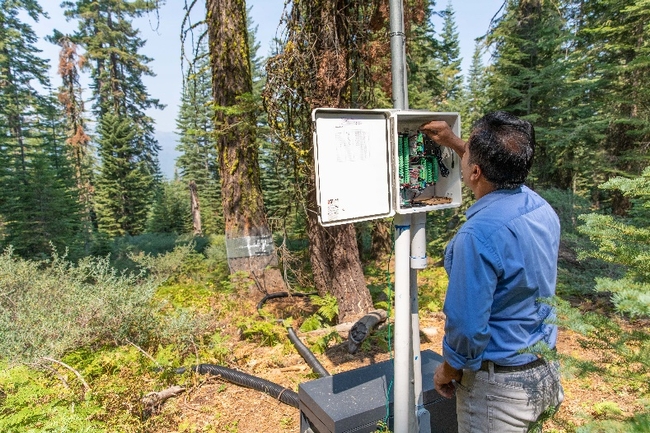Posts Tagged: Forest
Connecting California’s forest landowners with California Tree School
While trees and forests are often emblematic of constancy in a fast-paced world, our state's forests are actually changing before our eyes. Since 2020, the UC ANR Forest Stewardship Education (FSE) program has been helping California's forest landowners be proactive about the inevitable shifts their forestland will experience. The Forest Stewardship and Post-Fire Forest Resilience workshop programs use an online educational format, which guide landowners through the basics of creating forest management plans and managing post-fire landscapes, respectively. Now, the FSE team is piloting a new program to engage a wider audience of forest landowners and community members passionate about trees.
This spring, the Forest Stewardship and UC ANR Fire Network teams are holding the first California Tree School, where individuals attend multiple in-person classes on the forestry topics they are most curious about. “The existing online programs are very focused on forest management plans and post-fire activity, and [Tree School] lets us tackle other topics,” said UC ANR forest and natural resources advisor Susie Kocher.
A one-stop shop for continuing forestry education
California Tree School was inspired when Forest Stewardship Academic Coordinator Kim Ingram, Post-fire Academic Coordinator Katie Reidy and Kocher attended Oregon State University Extension's Tree School event in Clackamas County, Oregon. OSU Tree School is a day-long experience comprised of classes that cover the different dimensions of forestry: constructing a house from your own timber, carbon cap and trade, and buying portable sawmills are just a small sampling of the options for attendees. OSU Tree School students ranged from forest landowners to community college students, contributing to a space which would facilitate community connections as well as learning.
Kocher described the experience as a “a great one-day, one-stop shop to keep up-to-date on what we [forest landowners and professionals] should know.” Excited by the breadth of opportunities offered at OSU's Tree School, Ingram, Kocher and Reidy were inspired to bring the format to California.
“It's our time to discuss the whole ecosystem,” noted Reidy. “Tree School is bringing in the trustworthy, reliable group of experts who can provide more information on the questions pertaining to landowners' specific goals.”
California Tree School will be offered in two locations this spring, with CA Tree School- Hopland taking place on May 4, and CA Tree School- El Dorado on June 1. Similar to OSU's Tree School, attendees are expected to be a mix of forest landowners, natural resource professionals and interested community members.
Connecting statewide professionals; personalizing forestry education
Tree School offers attendees the opportunity to focus on subjects that pertain to their specific learning needs. This personalized approach is a new foray for the Forest Stewardship team, but is something that Ingram says workshop participants have been wanting for some time.
“Our participants never think they learn enough. They are always asking for more information, and this Tree School gives us the chance to expand on things we might not have had a chance to go over in the workshop series,” remarked Ingram. Additionally, Tree School instructors had creative freedom when it came to developing their classes, from the topic to the class format. This is evident when browsing through each session's class catalog. CA Tree School attendees choose four classes to attend, meaning they can build their first burn pile, understand the ins and outs of regional wildlife, paint outdoors and learn how to aid statewide reforestation efforts all in one day.
“I felt that Tree School created a sense of trust around complex topics,” noted Reidy about her experience last year in Oregon. For CA Tree School, the Forest Stewardship team aims to do the same. This meant recruiting from throughout the UC ANR network and other organizations, including CALFIRE and CARCD (California Association of Resource Conservation Districts), to bring trusted voices to the community.
“What's exciting about Tree School is that we are bringing natural resource professionals from all around to engage everyone at the same time, and all in one place,” noted Ingram.
The team is excited to see all the connections that will be made between community members and professionals during this pilot year, and “if this is successful and we can bring it back next year,” commented Kocher, “we are definitely interested in partnering with more people and expanding our outreach.”
Making CA Tree School an in-person experience was important to the team, as much of the education is hands-on. Additionally, Kocher sees enhanced potential for building personal connections: “In person, you have this opportunity for people to identify as part of a community,” noted Kocher, “So I'm excited for people to hang out with each other.”
Encouraging an informed community
“You can't separate the emotional from the physical, and there are a lot of topics in forestry like wildfire and economics that can be a bit of a downer,” said Ingram. “I'm excited to help create a positive learning environment, and one that encourages folks to turn to UC Cooperative Extension for these resources.”
“Our main goal here is to get science out there,” concurred Reidy. “The more exposure people have to science, the more confident they feel in themselves and their wants and needs.”
4-H youth project helps Siskiyou County prepare animals for emergencies
Planning brochure for pets, livestock fills crucial need as fires an increasing threat
With the McKinney Fire creeping closer to Yreka in the summer of 2022, Emily Jackson and her mother potentially faced the enormous task of getting all their goats, chickens, dogs and cats to safety – while Emily's father and twin sister Lindsay were away fighting the fires.
Fortunately, Emily and Lindsay had gained crucial knowledge about evacuating animals through a 4-H service-learning project they helped lead in 2018. A group of eight 4-H youths, ages 14 to 18, had created a “Pet Emergency Evacuation Plan” (PEEP) brochure, aimed at educating their neighbors in Siskiyou County about the necessary preparations for livestock and pets.
The brochure, available through the Siskiyou County website, remains in use today in this densely forested region that saw another spate of wildfires this summer. The PEEP project team was composed of Kylie Daws, Emily Jackson, Lindsay Jackson, Will Morris, Madison Restine, Maryssa Rodriguez, Emily Smith and Callahan Zediker.
Within those stressful hours in 2022 when the McKinney Fire prompted an evacuation warning during which residents could be required to leave at any moment, Emily Jackson said she and her mother had a game plan in place – thanks to her work on the PEEP project.
“At the time, it wasn't even on my mind,” Jackson said, “but looking back now, I know that having the experience from making that brochure was driving my thought process at the time.”
And while the Jackson family and their neighbors ultimately were not asked to evacuate in 2022, many community members have benefited from the hundreds of copies of the PEEP brochure in circulation, which prompts residents to at least think about what their animals would need in an emergency, Jackson said.
Pet and livestock evacuation tips were needed
Such a resource previously had not been available among the county's emergency preparation materials, according to Jacki Zediker, the 4-H regional program coordinator in Siskiyou County who advised the PEEP project group.
“One piece that was missing was how to help our communities understand that when they evacuate, and they take their pets with them…it's not as simple as just taking their pets with them,” said Zediker, citing the example that some shelters do not take in animals – or do not take animals without proof of vaccination.
Other items to add to the pet's emergency kit include food for several days, water, medications, comfort items or toys, and recent photos of the owner with their animal (proof of ownership).
Zediker had connected the young people with Jodi Aceves, senior deputy agriculture commissioner/sealer for Siskiyou County, who had been overseeing the county's Animal Control programs and emergency response.
“There's a lot of information out there for people evacuating, but not necessarily for livestock and pets,” Aceves said. “Unfortunately, we have had some fires where there were lots of pets and livestock lost.”
She met several times with the 4-H group, discussing the county's evacuation systems and processes and the role of the Office of Emergency Services and law enforcement agencies, and sharing key considerations in preparing for emergencies – such as having a pre-agreement in place with someone who could house an evacuee's animals.
Aceves praised the teens for distilling the vital information into a short and simple brochure that community members could easily read and remember. She also was impressed by the energy and genuine care that the young people put into the project.
“Most of their lives, every summer, they've been in fire,” Aceves said. “It's close to their hearts, and they've seen a lot of their neighbors and other people in the county either affected by fire or evacuated at some point.”
For Lindsay Jackson, in particular, fire and serving the community have been lifelong passions, inspired by her father's work in the area.
“My dad was a volunteer fire chief for the South Yreka Fire Department; he was doing that since I was about two or three, so I grew up watching him go to the trainings, go to a call,” she explained. “When I was 15, I joined the fire department as a cadet to help out with the medical side, but the more I volunteered, I really liked the fire side, too.”
Jackson added that Zediker has a special knack for nurturing and encouraging the interests of the 4-H participants and applying them in a productive way.
“Jacki was really good at figuring out where our passions were and then how we could put our passions into a service-learning project,” she said. “She knew I was really big into fire and helping the community in that way since I was young.”
Zediker also helped the Jackson twins on their senior project, a fire-safety field day at the South Yreka fire station. More than 100 schoolchildren learned fire safety basics, met firefighters and emergency personnel, and heard about 4-H from Lindsay and Emily.
4-H experiences, mentorship inspire career paths
The PEEP project group also was asked by several organizations to share their knowledge about emergency preparations for animals. In addition to presenting a poster about their work at the 4-H California Focus conference in 2018, the group handed out the brochure and shared information at a table during a Juniper Flat Fire Safe Council workshop and resource fair.
Beyond distributing the PEEP brochure at 4-H club meetings, school events and community meetings, the youths have lent their voices to advocating for emergency resources for animals. Zediker noted that they contributed testimonials that helped the county acquire grants for purchasing more portable kennels.
But the most enduring impact of 4-H participation and community service, however, is that those experiences were a springboard for the young adults' careers. Emily Jackson – who participated in 4-H from age 5 to 19 – is now working toward a master's degree in biology at Cal Poly Humboldt, studying how fire suppression and other factors have changed plant communities in the Russian Wilderness.
Whether training colleagues as a U.S. Forest Service crew lead for the past couple of summers, or leading lab sections in general botany as a graduate student, Jackson said she draws on her 4-H experiences – and Zediker's inspirational example – as she pursues a career in teaching.
“In my development as a young adult into an adult now, I cannot overstate how big of a role Jacki played in that,” Jackson said.
Her sister Lindsay, meanwhile, has pursued her passion for fire all the way through the fire academy at College of the Siskiyous, where she also earned her emergency medical technician (EMT) license. Most recently working on fires near Pondosa in Siskiyou County, Jackson has been a seasonal firefighter based at the McCloud CAL FIRE station since 2020.
“It's hard because, in the last three years, I haven't left Siskiyou County, there's just been so many fires here,” she said. “But it's nice being able to help your community and know you're making a difference.”
Lindsay Jackson intends to pursue a bachelor's degree in leadership studies at Cal Poly Humboldt in hopes of getting a full-time position with CAL FIRE.
Workshops for forest landowners come to Solano, Sacramento counties, beginning July 18
Free forester site visit for landowners who complete workshop series
Forest landowners in Solano and Sacramento counties are encouraged to learn about their forests and connect with natural resource professionals in their areas during the next Forest Stewardship Workshop Series from University of California Cooperative Extension, July 18 to Sept. 12. These programs can be essential for small landowners who seek to make their forests resilient against wildfire.
Upon completing the nine-week series of virtual and in-person sessions, landowners also will be eligible for a free site visit from a local Registered Professional Forester (RPF), Certified Range Manager or California Certified Burn Boss.
Content is applicable to all forest landowners regardless of where their forest is located and will highlight talks from the local Resource Conservation District, UCCE forestry advisors, CAL FIRE, Natural Resources Conservation Service, and other natural resources community leaders. Registration fee is $60 for the workshop series, which will address common concerns among California landowners, including but not limited to:
- Forest ecology and vegetation management
- Financial planning and cost-sharing opportunities
- Oak woodland management and targeted grazing
Past participants have rated the workshop series highly, with 98% of 2022 participants rating the series overall as excellent or very good. In addition, 94% of past participants reported greater awareness of applying for and using cost-sharing programs.
A past participant has described the workshops as very accessible, saying “they (UCCE) broke things down into small pieces, [and] staff were always an email away.” In seeking to make an otherwise large amount of content approachable, UCCE hopes that landowners come away with a holistic understanding of the management process.
The workshop will take place in a hybrid setting, with classes taking place weekly online over Zoom. Participants will also engage in practical learning through a field day, where they can meet other cohort members and UCCE professionals at an outdoor field location.
At the conclusion of the workshop series, landowners will be equipped with the knowledge and network that will empower them to manage their forests in ways that meet their specific goals and objectives.
Community members in Sacramento and Solano counties interested in forest management, forest and fire ecology, and related topics are encouraged to register: https://surveys.ucanr.edu/survey.cfm?surveynumber=28675.
Forest landowners across California can learn about upcoming workshops in their areas, and also find additional resources, publications and videos: https://ucanr.edu/sites/forestry/Stewardship/.
Top 10 tools for new forest landowners
Earth Day 2023 celebrates the ways in which we can all invest in our planet, and forest landowners play a considerable role in this. Part of being a forest landowner is deciding where and when to invest your time, money and energy. To assist them, the UC Cooperative Extension Forest Research and Outreach team collaborated with four experienced landowners to highlight 10 tools a first-time forest landowner can invest in.
Listed below, these 10 tools expand past saws and rakes to include tools that educate landowners and support their management activities. We hope this compilation gives readers new to forest management a proper start.
1. Management Goals: Every tool a new forest landowner buys should help advance a management goal. Each of the four interviewees emphasized that understanding what you and your land need is the number-one priority to be investing time and effort into.
“That's my management goal: a healthy forest with as much biology as I can support. Keeping the big trees, letting fire in every once in a while…and correcting the problems we've caused in the past. The species we have here now, it's mostly white fir. People took out the Douglas Fir, the Sugar Pine and you have to do enough thinning to replant those species because they're not coming in that fast underneath the dense fir forest.”
-Brent, Nevada County
2. Pruning and Cross-cut saws: When completing thinning or clearing projects, every forest landowner has their go-to saws. Cross-cut saws are used for cutting down trees, whereas pruning saws cut away dead or diseased branches. Don't forget to look outside of the box for your tools, as one landowner told us about her preference for Japanese tools.
“My Japanese pruning saw… it cuts like butter! It can easily take down trees up to four inches in diameter. The Japanese-made tools, they're smoother and sharper.”
-Danica, Sonoma County
3. A McLeod was cited by each of the four landowners as a must-have tool in every forest landowner's tool kit. One side can be used as a hoe and the other side as a rake, making it useful for activities ranging from trail building to raking in brush for a pile burn.
“For pitching stuff in and raking things out [of a pile burn], you're going to need a McLeod. And if you want to clear a brush pile, it's heavy. And it [the McLeod] works really well for that.”
-Brent, Nevada County
4. Succession or legacy plan: Thinking about who will take care of your land after you is a key aspect of successful forest management. However, bequeathing land to a family member isn't the only option. You could also consider donating your land to a local tribe or to group like the Nature Conservancy.
“[Regarding legacy] On the forest that we manage, we have a conservation easement so it can't be developed. But it doesn't stop it from being logged…How do you conserve? How do you decide? You can let an organization manage it, but it might be in their interest to thin [the forest]. I'll do what I can - I'll set it up for you [the next generation] and hope that there's a shift in the future and we'll learn to steward our resources.”
-Brent, Nevada County
5. Weed Wrench: What to do when you encounter an unwanted plant? When restoring native plants and clearing unwanted invasives, some species are more difficult to uproot than others. If your garden shears aren't cutting it, reach for a weed wrench like the one here.
“I have a lot of bay laurel and there's a lot of saplings that come up and they resprout vigorously. You have to literally pull it out by the root…so I use a weed wrench, and that's been a really valuable tool for me. It's also good for Scotch Broom, anything that has a small diameter neck that you can clamp on to and leverage out.”
-Sacha, Humboldt County
6. Newsletters: Sometimes reading about what other landowners are doing can help you find inspiration for management activities. The Forestland Steward newsletter, which covers general forest management news and events, would be a good place for a new landowner to begin. Additionally, subscribing to newsletters that cater to your region and management goals is a simple way to find applicable management recommendations.
“I subscribe to a bunch of email newsletters, and those are constantly talking about…like, what upcoming events are going on? What are educational conferences going on? I'm constantly getting research articles, casual writings, webinars…For me, I'm personally interested in good fire, so I subscribe to a lot of resources that are focused on using fire as a land management tool.”
-Sacha, Humboldt County
7. Record keeping: Come tax season, you will thank yourself for investing time in keeping records of your management activities. If you find yourself receiving funding in the form of grants, conservation easements or other programs, having a trusted tax advisor or accountant should be a consideration. A close collaborator with the Forest Stewardship Program, Larry Camp, (Registered Professional Forester, forest landowner and retired IRS agent) notes, “Treating your forestland as a business or investment is an important step forward in efficiently managing your forest and can lead to incentives and deductions that will legally reduce your tax burden.”
8. Land History: For many forest landowners, learning about indigenous history is not only fascinating, but a thoughtful reminder of the original caretakers of California forestland. Investigate your land and delve into Traditional Ecological Knowledge (TEK), which may inspire new projects.
“When we're talking about land and access to land, I think it's always good to be thinking about tribal sovereignty, and what are actions we can do to support that. Historically, this [land] was an oak woodland…we're playing catch up over 150 years of fire suppression policies. I'm working towards oak woodland restoration, and part of that is that tie-in to responsibility to tribal access.”
-Sacha, Humboldt County
9. Management education resources: Though we at UCCE have our own Forest Stewardship Workshop series, there are often informational webinars and videos offered through regional organizations. The California Wildfire and Forest Resilience Task Force website has a list of educational resources for landowners, found here.
“I'm big on education, and when you're participating in that educational group, they [program participants] might throw out a different name, or a different agency you can use. It's really about being involved and taking up the suggestions that people give you.”
-Laura, Nevada County
10. Community: Getting connected with organizations like your local Resource Conservation District (RCD), Natural Resources Conservation Service (NRCS), CAL FIRE, or UC Cooperative Extension (UCCE) office can be a big help to new landowners. These organizations house experts such as Registered Professional Foresters (RPFs) who can provide technical assistance and assist in applying for permits or drafting a management plan. Devote time looking into region-specific organizations such as the Foothill Conservancy and My Sierra Woods that service multiple counties. Peer networks are a plus as well. Community ties were continuously cited by the forest landowners we spoke to as being a valuable resource.
“Try to figure out what organizations are around you that are doing stuff. Around here, there's the Mid-Klamath Watershed Council, and they'll have invasive plant removal days, and you can go and volunteer. Doing something like that, where you're hands-on and connecting with other people is what I'd suggest.”
-Sacha, Humboldt County
“My community…is definitely close knit, because it's tough! It's a lot of work. And, you know, if I'm renting a chipper and it's up at my property and someone else wants to use it, they can. It's very, very helpful to be close with your neighbors and learn from them.”
-Laura, Nevada County
French Meadows partnership completes fourth season of work
Safeeq Khan of UC ANR among collaborators on forest treatments in the Sierra
Despite the challenges of an extremely dangerous fire season, including California's largest wildfire in 2022 (Mosquito Fire) impeding access and limiting operations, partners of the French Meadows Forest Restoration Project have wrapped up their fourth season of forest treatments in the critical headwaters of Tahoe National Forest. Safeeq Khan, Cooperative Extension specialist in water and watershed sciences with UC Agriculture and Natural Resources, is among the collaborators.
This season, project partners safely treated over 700 acres of federal land using a combination of mastication, mechanical thinning, hand thinning and prescribed fire. On adjacent private land, the American River Conservancy independently raised funds and treated 338 acres. Combined, this all-lands collaborative watershed management project has treated over 6,000 acres in just four seasons.
Work this season focused on areas most prone to wildfire ignition. The United States Forest Service treated over 200 acres with prescribed pile burns in and around the Talbot campground, improving the aesthetic quality of this important recreation area just north of French Meadows Reservoir. Although dry conditions limited the scope of prescribed burns this year, using fire as a management tool is a cost-effective way to maintain forest conditions that contribute to ecosystem resilience and human health and safety.
“Prescribed burns are a critical component of the partnership's ecological forestry model,” explained Edward Smith, forest ecologist and fuels manager with The Nature Conservancy. “Under ‘prescribed conditions' of wind, moisture and temperature, broadcast burning helps reduce the amount of tinder on the forest floor as well as fuel ladders that could otherwise carry wildfires into the tops of trees, protecting habitat for humans and diverse wildlife species. Fire also reduces brush and twigs to ashes that feeds the roots of trees and understory plants, protecting the soil and its microbial universe, making them more resilient to drought, insects and climate change.”
Mechanical thinning, hand thinning, and mastication operations continued in areas surrounding water research instrumentation, installed by the Sierra Nevada Research Institute at the University of California, Merced. Over the coming years, researchers will be assessing how vegetation changes in ecologically-based forest management affect water quantity in the local watershed.
“Optimal restoration of forested headwaters benefits from dedicated partnerships collecting scientific data,” said Khan, who is also an adjunct professor of civil and environmental engineering at UC Merced. “UC Merced is working to provide this dimension at French Meadows with strategic measurements and modeling.”
Perhaps the partnership's biggest success in 2022 was securing, via multiple grants, the remaining funding necessary to complete all the thinning operations defined in the original project plan. Since the project's inception more than six years ago, the partnership has operated under an innovative funding arrangement consisting of local, state and federal dollars combined with private donations.
“What has impressed me most about the French Meadows partnership is its commitment to see the project all the way through: start to finish,” said Tahoe National Forest Supervisor Eli Ilano. “With the new funding secured this year, we will be able to wrap up thinning operations, and turn our focus to managing and maintaining the land for the enjoyment of the public.”
American River District Ranger Mary Grim with the U.S. Forest Service added, “This partnership learns from each year to adaptively manage for resilient forests that benefit everyone. The French Meadows Project is a reminder of what can be accomplished with a shared sense of stewardship for our forests and natural resources.”
Fuels reduction work this season resulted in more than 1.066 million board feet of overstocked timber, which was brought to a local mill, with the revenue generated offsetting some of the restoration costs. Project partners also repaired over seven miles of roadway and culverts to reduce sedimentation.
“Under the threat of a second consecutive severe fire season, including the Mosquito Fire in our own ‘backyard,' the partnership diligently moved treatment activities forward and began discussions on how to sustain the project's benefits through long-term maintenance planning,” said Kerri Timmer, regional forest health coordinator with Placer County, who coordinates the stewardship agreement with the Tahoe National Forest.
The catalyst of the French Meadows Forest Restoration Project was the 2014 King Fire, which burned over 97,000 acres in the American River watershed, much of it at high intensity. Eager to reduce the risk to hydroelectric assets, water quality, and biodiversity from future high severity wildfires, Placer County Water Agency joined with Placer County, The Nature Conservancy, the United States Forest Service, American River Conservancy, Sierra Nevada Conservancy, and the Sierra Nevada Research Institute at the UC Merced, to form the French Meadows Partnership.
The project spans more than 22,000 acres of federal land, nearly 7,000 acres of private land, and is a test case for the partnership's effectiveness in improving fire resilience and the overall health of the watershed.
To learn more about the French Meadows Forest Restoration Project, visit and tour the Project's story map.

